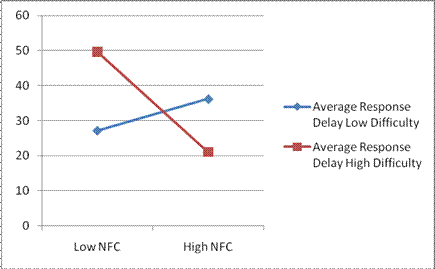Media Effects Research Lab - Research Archive
Becoming invisible through IM: A third order effect
Student Researcher(s)
Daniel Halpern (Masters Candidate);
Pan Shi (Masters Candidate);
Ying Chen (Masters Candidate);
Faculty Supervisor
INTRODUCTION
IM poses the paradoxical consequence of simultaneously decreasing work delays (firstorder effect), but increasing work interruptions (second-order effect). The third order effect is: users in IM systems might change their degree of social presence to invisible in the same way that they do in their off line relationships in order to avoid interruptions.
RESEARCH QUESTION & HYPOTHESES
Research Question: how individual differences might affect IM uses and specifically the tendency to be invisible.
H1: Individuals with a high need for control will show a higher preference to initiate conversations
H2: Individuals with a high need for control will show a higher preference to communicate asynchronously to answer conversations
H3: Individuals with a high need for control will evaluate better the IM application (allow them to choose individually the degree of visibility)
METHOD
We designed an experiment in which firstly participants were surveyed on their affinity level, and then every 3 participants were grouped to either “friend” group or “stranger” group based on that. After then, each group was asked to play a puzzle solving game by collaborating through an IM application. There were two kinds of levels in the game: easy and difficult, and participants were asked to play both, in the sequence that easy levels first and then difficult levels. During the time they played the game, they kept receiving interruptions from IM application every 2 minutes, and the only way to avoid interruptions is to change their status to invisible. After they finished both levels, they needed to fill out a questionnaire to measure their need for control level and the evaluation of the IM tool.
RESULTS
• H1 not supported, the preference to initiate conversations between individuals with high need for control and low need for control don’t have significant difference.
• H2 is partially supported, in the easy task, individuals with a need for control show a higher preference to communicate asynchronously to answer conversations, but in the difficult task, it change to the opposite (Figure 1).

Figure 1. Interaction between task difficulty and need for control
• The amount of data is not sufficient for us to measure H3.
Other findings:
1. The number of initiate times in easy task is much more than difficult task (p< .001).
2. participants who have high need for control initialize much more conversations in friends group than in stranger group (p = 0.036);
3. Male in high difficulty level task initialize much more than female (p < 0.05*), and in low difficulty level task male’s response delay is much shorter than female’s (p< 0.05);
4. The group leader’s average initialize rate is significantly less than others (p < 0.05), while in high difficulty level, group leaders’ response delay is significantly longer than others (p < 0.01);
CONCLUSION
Our explanation of the hypothesis not being fully supported is high need for control participants would have a stronger motivation to complete the collaboration task so that they would pursue a higher efficiency than participants with low need for control. And findings demonstrate that users are more prone to interrupt others when they are using less cognitive resources and have more confidence.
To sum up, people with different level of need for control, in different position (leader or member), doing different tasks (easy or difficult) will require different functionality of IM applications. Thus, it is reasonable to embed policy setting function to IM application design which enable user to specify their using preference.
For more details regarding the study contact
Dr. S. Shyam Sundar by e-mail at sss12@psu.edu or by telephone at (814) 865-2173

